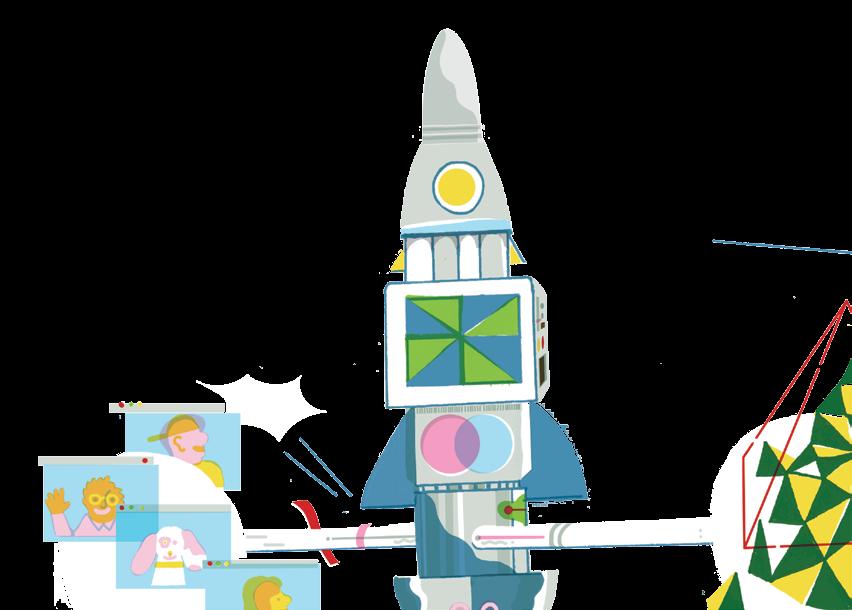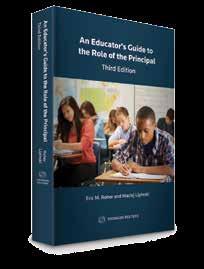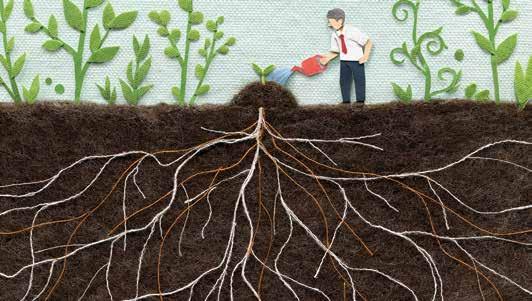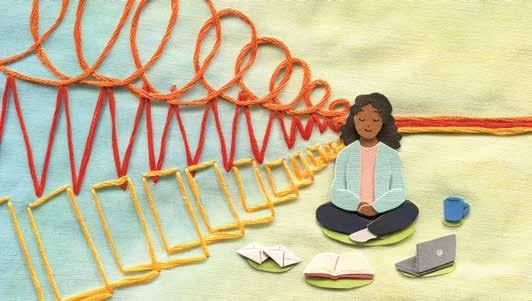
10 minute read
Designing Schools of the Future
Fu t u r e t th e e u d e s i g n i n g s c h o o l s o f f u t u r e . u

Advertisement
Unlocking student wisdom


Given a blank slate and unlimited resources, Canadian youth were asked how they would design a school learning environment on Mars. We collected 10 insights into how they would re-shape their education.
With growing awareness about the challeng
es and pressures faced by schools to ensure
students graduate prepared to thrive in an
increasingly complex world, the time was
right for a collaborative and respectful na
tional discussion about the future of science,
technology, engineering and math (STEM)
education.
What began as an idea for a national educa
tion conference with senior leaders morphed
into a robust consultation that included five
youth summits; a series of millennial round
table discussions; and a national conference
with federal, provincial and territorial deputy
ministers and education, industry and com
munity leaders.
Led by Let’s Talk Science and partners 1 as part
of Canada’s 150th birthday celebrations, this national initiative called Canada 2067 set out to determine whether diverse stakeholders share a common view of what is needed in Canada to evolve and shape the future of STEM education for students in Kindergarten to Grade 12.
This in-person consultation process, online polling that garnered over 500,000 inputs and research into international education policy initiatives influenced the development of what is now the Canada 2067 vision and Canada 2067 Learning Roadmap.
Some of the most valuable insight came from the 1,000 Grade 9 and 10 students who participated in a thought-provoking conversation about how they would re-build the Canadian education system – on Mars.
STUDENT CONSULTATION The full-day student summit events were designed to ignite their interest in STEM and seek their input around the six pillars identified through global education policy research: • how we teach • how we learn • what we learn • who’s involved • where education leads and • equity and inclusivity.
Between October 2017 and April 2018, we hosted five Canada 2067 youth summits in partnership with school districts in Vancouver, Calgary, Toronto, Montreal and St. John’s.
Students were chosen based on their interest in participating in the consultation; many said they were not particularly interested in pursuing STEM themselves. Each summit opened with a diverse series of short and inspiring “STEM
FOOTNOTE
1
Canada 2067 was led by Let’s Talk Science with key partners including Dr. Andrew Parkin (then Mowat Centre) who led the policy research; Groundswell Projects and the Institute without Boundaries (George Brown College) designed the youth summits; Global Shapers hosted millennial roundtable discussions; Hill + Knowlton Canada designed the Canada 2067 hub and implemented the online polling; the Council of Ministers of Education, Canada and the Canadian Teachers’ Federation informed and participated in the national leadership conference. The Canadian Space Agency ensured the participation of an astronaut or senior space official at every event. National funders included the Government of Canada, Trottier Family Foundation, 3M Canada and Amgen Canada.
Talks,” including space-related careers. Afterwards, students worked for several hours in small pre-assigned groups, each charged with exploring one of the identified pillars with a volunteer facilitator. Collectively, teams were asked to design the first school system on Mars.
They inspired us to document their contributions, including many novel project ideas, in a short book available for free download. There were distinct regional perspectives, but, interestingly, 10 insights surfaced prominently at every youth summit.

THE 10 KEY STUDENT INSIGHTS
h ow we teach 1. Personalization & customization:
The future of STEM education doesn’t look the same for everyone. Students want richer engagements with their teachers, including more one-on-one time that could help them understand their learning strengths and create custom learning experiences. They are having trouble feeling motivated by the curriculum and wish their personal interests and passions could be tapped into more often at school. Evaluations would start with capturing student goals, their effort and progress, as well as curriculum mastery.
h ow we lear n 2. Collaborative participation:
Students want to be active agents in their education. Overall, they are enthusiastic about the opportunity for the school to be a learning environment for everyone, including their teachers and administrators. Students envisioned being more involved in setting learning goals and tracking progress in more diverse ways. They would include more extracurricular opportunities, as well as independent work and and teamwork as part of the evaluation process.
3. Technology everywhere: The future of STEM education embraces technology. Students feel schools are being left behind when it comes to technology, and they don’t understand why they often have to use the same technologies their parents used in school, instead of using their smartphones. Their dream is for the latest technologies to be accessible to all students and used to enhance their learning. Students also referenced using technology differently to improve evaluation processes.
what we lear n 4. Changing the arc of education:
Students think STEM learning could change the entire approach and start in the early years to develop foundational skills and language. By middle school, they’d shift to STEM for self-development and exploring their interests. High school would include more access to experts in the community, regular exposure to possible pathways and more opportunities for job experiences like co-ops. Currently, they are not motivated by the extent of theoretical instruction they receive.
5. Experiential learning: Students would be motivated to learn and develop competencies by connecting STEM concepts to real-life prob



lems in a hands-on way. There were strong calls to collapse the disciplines, integrate STEM with humanities and arts, and use real problems to deepen their understanding of foundational theories through application. They seek more opportunities to engage in learning outside the classroom with real-world practitioners working on solutions to challenges. Evaluations would shift to include effort, behaviour and improvement. In turn, marks would lose their current stronghold in defining student identity.


problems in a hands-on way. There were strong calls to collapse the disciplines, integrate STEM with humanities and arts, and use real problems to deepen their understanding of foundational theories through application. They seek more opportunities to engage in learning outside the classroom with real-world practitioners working on solutions to challenges. Evaluations would shift to include effort, behaviour and improvement. In turn, marks would lose their current stronghold in defining student identity.
who’s involved 6. Mentorship:
Students crave relationships with caring and trustworthy adults and consistent exposure to experts outside of school. They want help with navigating school, including understanding the fundamental act of learning how to learn and interact with teachers. They want help in learning to cope with stress and bullies as well as how to stay motivated. They seek advice about pathways and support building healthy lives.
where education leads
7. Critical thinking and problem solving: To be resilient and flexible, students need to develop critical thinking and problem-solving skills. Students are aware that they need to become experts at deconstructing ideas and developing their own informed points of view. They stressed the value of practicing skills using relevant contexts and the importance of formalizing post-project


reflections. They are looking for more opportunities to practice sharing their ideas in diverse ways – by speaking, writing, making and prototyping.
8. Self-awareness and direction: STEM education will help students develop self-awareness to build on strengths, improve limitations and move in new directions. They want to connect academic skills, character traits, passions, behaviours, values and aptitudes to the job market.
equity AND inclusivity 9. Well-being:
Students envision a culture that supports feeling good in your own skin and developing the skills to help others feel good in theirs. They are feeling the weight of stress. They want a school system where the happiness of students, teachers and administrators is paramount. They want to be in a place that is supportive and inspiring, where diversity and inclusion are practiced. Their vision for healthier schools includes healthy and affordable food, frequent breaks for movement and rest and flexible schedules that are more in harmony with the circadian rhythm of teens.
10. Space and comfort: Students want safe, clean, bright and inspiring spaces with more natural light, large flexible spaces that support diverse uses and different types of areas, including labs, maker-spaces, kitchens and libraries. There would be spaces designed to connect socially, places to work in solitude and in collaboration. In addition to cutting-edge technology, students want environmentally responsive and sustainable buildings.
HOW THE CANADA 2067 INITIATIVE IS INFLUENCING CANADIAN EDUCATION While the students imagined learning on Mars, in several provinces across Canada there are new initiatives underway that align with or are also reflective of the Canada 2067 recommendations.
Ontario The Halton District School Board (HDSB) has used the Canada 2067 Learning Roadmap as a guiding framework for the development of its new I-STEM program. The areas of focus (e.g., How we learn, What we learn, etc.) anchor the work of the I-STEM Advisory Team, which is composed of diverse stakeholders (staff, parents, post-secondary, industry, community). They are referencing the guiding recommendations as the team builds and reflects on the learning for students and further program development.
The 10 key youth insights, coupled with HDSB’s Student Focus Group results, provided student voice to frame the learning experiences for students. As a result, I-STEM learning is more interdisciplinary, issues-based and experiential. Students in I-STEM have opportunities that support invention and innovation to make a difference in the world. Connections with post-secondary education partners, industry and the broader community bring authentic issues-based learning opportunities to the students. The I-STEM Program Overview and Year 1–Engineer’s Toolkit reflect the vision for learning in I-STEM.
Nova Scotia Let’s Talk Science, in partnership with the Government of Nova Scotia, is supporting the implementation of the new science curriculum by providing professional development for school administrators that incorporates Canada 2067 recommendations. katchewan, broadcast technology provides job-embedded professional learning for educators and students in a co-learning environment to build skills in computational thinking and coding.
BUILDING A FUTURE WITH CANADA 2067 As we look towards the bicentennial year when many of today’s teens will be considering their retirement, it’s clear that we can’t wait 50 years to improve STEM learning! With students at the centre, Canada 2067 offered a powerful platform to engage diverse stakeholders in discussing the future of STEM education. The positive participation and strong alignment across all audiences indicated an understanding that change is needed and that a collaborative approach offers a constructive path forward. Keeping students engaged as active participants in their learning and learning environment will help lead to a collaborative design for the future of education, and a guide to building the resilient problem solvers of tomorrow.
Dr. Bonnie Schmidt, CM, FRSC, is the President and Founder of Let’s Talk Science. @LetsTalkScience bschmidt@letstalkscience.ca
FURTHER READING
All Canada 2067 reports are hyperlinked below and available in English and French at Canada2067.ca. Additionally, videos from the youth summits and national leadership conferences are also available online.
CANADA 2067 LINKS
Canada 2067 Learning Framework – overview (English / French) Canada 2067 Learning Framework – full (English / French) Research Backgrounder – overview (English / French) Research Backgrounder – full (English / French) Youth Insights Book (English / French) Youth Insights overview (English / French) Youth Summit Videos (overview /event pageEnglish / French) Global Shapers Millennial Report (English / French) National Leadership Conference (English / French)









